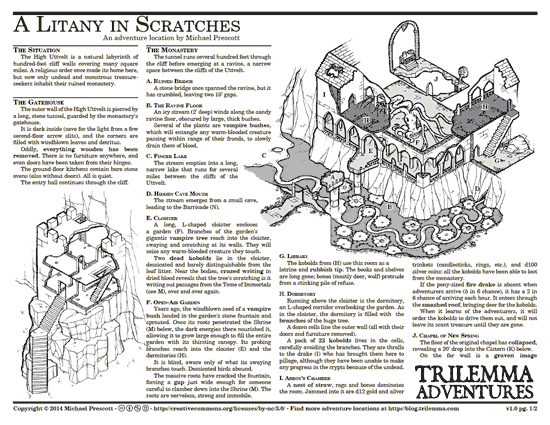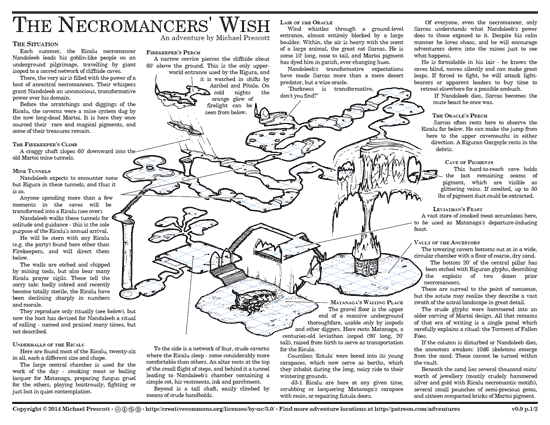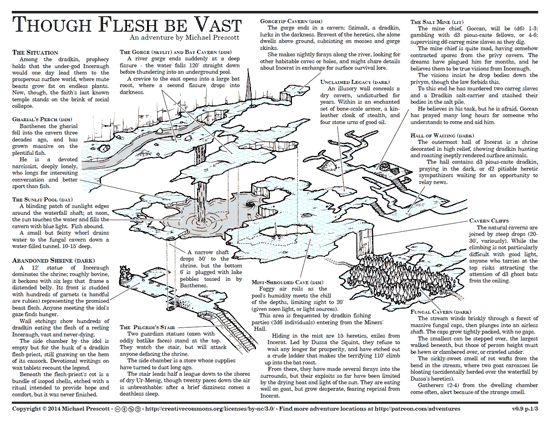In Ben's original
West Marches campaign, he arranged the adventure-filled regions of his wilderness in order of challenge, more or less. The further you were from town, the more likely you were to be in an extremely dangerous place.
This works fairly naturally in a game like D&D, which has an extraordinarily steep power curve. A party of tenth level characters can take on large numbers of monsters that are quite dangerous when they first set out.
In other game systems, though, power levels aren't nearly as steep. In games like Warhammer FRP,
Burning Wheel, or
E6 (and I hear
RuneQuest), characters don't ever get so powerful that they can laugh at mundane threats like they can in D&D.
In games like this, what are some ways to pull off escalating difficulty?
In
Dungeon World, and its stripped-down cousin
World of Dungeons, there's almost no quantification of monster power level
at all. These games aren't about flat power curves, necessarily, (they just don't make statements about power) but the effect is the same. What are some non-mechanical ways to tweak the danger level?
Ben tells an anecdote about his players
fleeing from goblins for days, ultimately having to run so far they fled into a vermin-filled swamp. He also talks about the barrow wights in the otherwise pleasant Wil Wood - dangerous, but easily avoided, and in fact not that easy to find.
These got me thinking about
non-mechanical difficulty levels for monstrous threats in general.
The lens I'm looking at this subject through is stocking a west marches-type wilderness map, so I'm thinking of this in terms of concentrations of monsters - factions, settlements, lairs, and so on. It could be a single owlbear, or an entire subsurface city of Derro.
Here's what I've got so far.
Controlling the Degree of Danger
This is the general principle -
how much control do players have over the degree of danger? Can they get a taste and pull back, or does moving forward risk pulling down more than they bargained for?
Speed
It's easy to get away from
Slow monsters. Maybe they're just slow all the time, maybe they're fast in short spurts but can't match the adventurers for endurance (like cheetahs). Maybe they just suck in the terrain the encounter occurs in. In any case, the players can control difficulty by just walking away.
It's much harder to escape from
Fast monsters. Maybe they have a terrain advantage, maybe they know shortcuts. Maybe they have mounts, or long legs. But as long as they can find you, they control the distance.
Cohesion
Unorganized monsters can be dealt with piecemeal - maybe they communicate poorly, maybe they hate each other. Angering one won't necessarily mean angering the others, and even if it does, they're not organized enough to do anything about it.
Factional monster concentrations are broken into smaller groups that don't quite get along. They have great communication within the smaller groups, but organizing beyond that is fraught. Pissing off one faction probably won't prompt an immediate reaction from the others, could actually win friends.
Cohesive groups have set internal conflicts aside, and are willing to pull together for the common good, sometimes rapidly.
Militaristic groups are not only willing to work together, they've drilled for it. Sometimes they're praying for it. Their response to external threats will be quick and decisive.
Gestalts are extremely dangerous - they are so cohesive that the entire community can respond as a single organism.
Territoriality
Defensive creatures just want to be left alone - they might even avoid the party if they can. If cornered or attacked, they might react violently, but the motive is to intimidate intruders to drive them away.
To Territorial monsters, on the other hand, just being around is a threat. Moose might not want to eat you, but they'll pursue you until you wish you'd never set eyes on them.
Vengeful monsters don't just want you gone, they want you to remember them. Maybe they send bounty hunters, trackers, rangers or wargs after you. Predatory monsters are similar.
Proactive monsters aren't waiting to stumble into you, they're on the lookout for threats before they develop, and will act to neutralize them before they get out of hand. They know what you people from the lowlands are all about, and they're not having any of it. If they get the drop on you, they'll mess you up just to send a warning.
Perceptiveness
The quickened trees of Grilwood might be organized, vengeful, but are so Oblivious that unless you smell like orc or try to cut one down, they probably won't even know you're there.
Inattentive monsters aren't expecting to meet anyone, while Alert ones do from time to time.
A Vigilant threat, on the other hand, may have scouts, spies, keen senses, or magical scrying.
Range
The Sarlacc and Blood Willow are nasty, but controlling your exposure to them is relatively easy because they're Stationary. Territorial monsters might be bad, but they're not so bad if their territory is only the graveyard you were digging in. Some are Site-Bound and don't leave the site where they are found, others will venture in the Local area, and some will have a wider Territory. Still other threats will have a Regional reach, able to come and get you long after you thought you were safely back in town.
Numbers
Singular or threats can be dealt with decisively (whether by evasion, bribery, negotiation, or violence) in a single encounter. Numerous creatures are not so easily dealt with, and Hordes are impossible to stop with anything less than an army, or cataclysmic magic.
Obscurity
How well does the party understand what they're dealing with? Do they know the lay of the land, the nature and disposition of the threats? Are their weaknesses, strengths, and motives understood? If the threats are
Understood, the party is at least aware of how much trouble they are likely to bring down on themselves. If the threat is
Unknown, the party may not realize it's in danger at all.
I'll talk a lot more about this in another blog post.
Other Qualities of Disposition
These factors have a more complex effect on threat level.
Inaccessible sites are those with obstructed approaches - defenses, narrow defiles or bottlenecks, town walls or ruined fortifications, difficult ascents or caverns, or a long trip across the desert. These barriers may confine the danger making the surrounding area safer, but once the obstacles are crossed, retreat can be difficult.
If a threat is Hidden, this takes control out of the players' hands, and multiplies the effects of the threat's territoriality. Hidden/Predatory threats are a big problem, while Hidden/Defensive sites may never be found at all.
Sealed threats are somehow confined, imprisoned, or penned in. Perhaps a cave-in has trapped underground dwellers, a barricade is preventing the crypt ghouls from flowing into the rest of the dungeon, or demons are trapped behind a door of black granite. These barriers offer parties at least an opportunity for control - don't break the seal, and you're safe. Once the seal is down, however, it's usually hard to put back.
In some cases, only experienced parties can break the seals, which is a useful way of shaping the danger level.
Overall Threat Level
These individual factors all combine to produce an overall threat level. Fast, Militaristic and Predatory makes for a much greater threat than just one or two of those factors.
By these standards, it's easy to see why the barrow-wights of the Wil Wood aren't a great danger to parties that wander through the area - they may be Territorial and Unknown, but they are also Unorganized, Inattentive, Hidden, and Site-Bound, giving players a lot of control over the danger they invoke.
The goblins, however, were much more dangerous - Fast, Cohesive, Vengeful, Alert and Numerous.
The
Orcs of Tirru-Stryggal from adventure #09 are almost as deadly as they come: Hidden, Regional, Vigilant, Fast, Militaristic, Predatory, Fortified, Unknown, Numerous. This is a threat that will destroy all but the most prepared and capable parties that tangle with them.
P.S. Once My Enemy, Now My Friend
Interestingly, the danger posed by these various qualities flips around when we consider our allies. It's much more useful to make alliances with Fast, Cohesive and Vigilant settlement than with an Oblivious, Factional and Site-Bound group. Those are like to bring as much trouble as they do aid. Hidden, Inaccessible and Sealed supporters aren't very useful either!




































